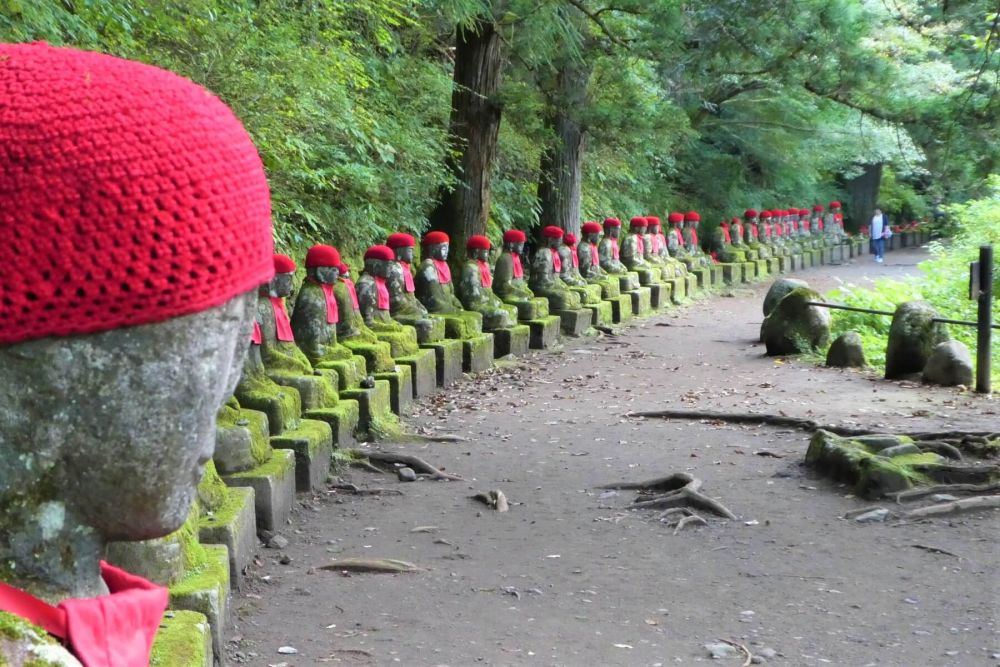

Kanmangafuchi Abyss is a scenic volcanic gorge located along the Daiya River in Nikko, a city that lies in the mountainous areas of Tochigi Prefecture, Japan. The area is known for its natural beauty, historical significance, and spiritual allure, aspects that have been attracting visitors for centuries. The history of tourism in Kanmangafuchi Abyss can be traced back to the Edo period when Nikko itself became a popular destination for pilgrims and travelers.
Nikko's Historical Significance: In the 8th century, Shodo Shonin, a Buddhist monk, established the first temple in Nikko. By the 17th century, Nikko's reputation as a sacred site was solidified with the construction of the ornate Toshogu Shrine, dedicated to the deified spirit of Tokugawa Ieyasu, the founder of the Tokugawa shogunate. The eruption of nearby Mount Nantai created the gorge known as Kanmangafuchi around this time. The natural environment gradually became part of the pilgrimage routes with travelers coming to marvel at the abyss.
The Rise of Spiritual Tourism: A key attraction within Kanmangafuchi Abyss is a collection of Jizo statues, known as "Bake Jizo" or "Ghost Jizo", which are believed to represent the spirits of those departed. The statues are an iconic feature that has drawn visitors looking for spiritual connection, peace, and reflection. The path along the gorge, providing views of the rapid waters and lush greenery, has been a contemplative route for both religious pilgrims and nature enthusiasts.
Development of Infrastructure: The development of roads and railways during the Meiji Restoration and onwards made Nikko, and by extension, Kanmangafuchi Abyss more accessible to tourists. The construction of Lake Chuzenji and the scenic Irohazaka winding road nearby contributed to the area's popularity.
Tourism in Contemporary Times: Today, Kanmangafuchi Abyss remains a well-preserved natural spot that attracts visitors year-round. While summer offers a lush, green landscape, autumn is particularly popular for viewing the vibrant fall colors. The site's proximity to other cultural landmarks, such as Toshogu Shrine and Rinno-ji Temple, adds to its draw as part of the larger Nikko experience.
Responsible Tourism: In recent years, there has been a growing emphasis on sustainable and responsible tourism practices in Nikko. Efforts are being made to preserve the natural environment of Kanmangafuchi Abyss while accommodating tourists. This includes regulating foot traffic and ensuring that the pathways and surrounding areas are kept clean and undisturbed.
Experiential Travel: Modern visitors to Kanmangafuchi Abyss are seeking more than sightseeing; they are looking for authentic experiences. Local tour operators now offer guided walks that delve into the historical and cultural context of the gorge and its surroundings, providing a deeper understanding of the area's significance.
Digital Engagement: With advances in technology, there has been an uptick in digital engagement among travelers. Online platforms and social media play a role in sharing the allure of destinations like Kanmangafuchi Abyss. Virtual tours and interactive maps have become tools to pique the interest of potential visitors, with some options allowing for a preview of the scenery from afar.
Off-Peak Exploration: To avoid overcrowding and to promote sustainable tourism, encouraging off-peak travel to Kanmangafuchi Abyss has become a trend. Travelers are increasingly visiting during quieter periods to experience the serenity of the area without the throngs of peak tourist season.